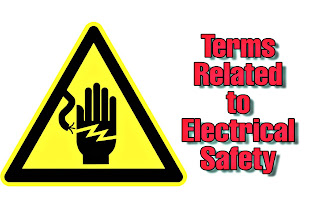Terms Related to Electrical Safety
 |
| Terms Related to Electrical Safety |
(1) Safety
Any method or technique or process which can minimize unwanted events or accidents is called as safety.
Industrial safety is mainly concerned with minimizing hazards in the industries.
(2) Hazard
Hazard is a potential condition a waiting to be converted into an unwanted event or accident
When the insulation on live conductor is worn out, or becomes weak, then short circuit takes place. Heat is produced, fire takes place, resulting into electric hazard.
(3) Accident
An unwanted event which can't be anticipated in advance may be termed as an accident. It is always a sudden process and not a gradual one.
As per factories Act 1948, an industrial accident has been defined as "an occurrence in an industrial establishment causing bodily injury to a person which makes him unfit to resume his duties in the next 48 hours.
Electrical accidents are caused due to lack of earthing, negligence during work, no use of safety devices, overconfidence, working on live wires etc.
(4) Major Accident Hazard
The major accident hazard is one, in which person coming in contact with machinery, equipment, gets severe shock may result into death of the person in contact.
Such mishap occurs, While ironing cloths, with the steam iron, the water may come in contact with heating element and leakage current may flow.
The leakage current may enter into a person body who operates the iron. And if earthing is not provided properly, the person receives electric shock.Most of the major accident hazards are due to no earthing connection, faulty earth, working on live mains.
You May Also Read:
(5)Responsibility
When electric, accident takes place, there is possibility of death/damage to the organs.
The relatives of the victim want the financial
compensation.
Here, it is always seen that who is responsible for this accident. The meaning of responsibility is who is responsible for accident. Who was in charge of that work where the accident took place.
Lastly in such cases, the responsible person has pay compensation for such act, through law of courts. If not, he may be imprisoned.
P.W.D.(Electric)particularly inspection wing acts as impartial third party to fix up the responsibility of electrical accidents.
(6) Authority
The person who is authorized, for execution of work is called Authority. The electrician and staff must obey the orders, instructions of authority.
If the electrician at his own works on live line, and gets fetal shock, he himself is held responsible for this act.
(7)Accountability
It is the responsibility of the person, for a particular work he is carrying. He is answerable and punishable for his failure, faults in the work he is carrying.
Due to privatisation, the Accountability has increased. Accountability includes time period, quality, mistake in any work assigned to him.
(8) Monitoring
Monitoring is done by superiors. It relates with work carried out by his staff. The Executive engineer in P.W.D.(Electric) or Maha Vitaran Monitors the work carried by the staff and gives the suggestions in connection with electrical work.
Even the monitoring of electrical machines is done for maintenance. Monitoring means keeping continuous watch or observation with remedial measures M.S.B.T.E. is also carrying academic monitoring.

Comments
Post a Comment